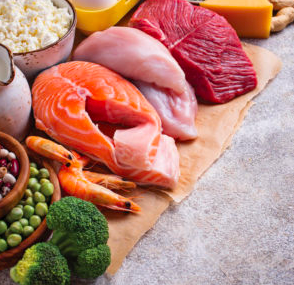Get our exclusive report. Download the iSport360 Club Switching Report Here – For Club Admins, Rec Leaders and Coaches.
Protein and the Student Athlete: How Much, When and Why
Protein comes from the Greek word meaning “of first importance,” which seems appropriate once you consider its numerous functions. Learn about protein and the student athlete: how much, when and why. Protein plays a key role in many aspects of health for athletes and adults alike (in fact protein contains something called essential amino acids that the body needs but can’t make, we will cover more on that below).

MVP Parent – Protein Article
But due to recent release of documentaries, books and other media on plant-based eating, people (even student athletes) have never been more confused on how much protein they should eat…or if they even should eat it at all?! In this article we will cover protein for the student athlete: why it is important, how much to eat, when to eat it, where to get it and to how to best prepare it. You will hopefully take away that your student athlete can (and should) eat both a plant-based and protein-rich diet to perform, recover, grow and be well – score!
But First, a Little Chemistry
Protein is a macronutrient, along with carbohydrates and fats. Macronutrients (AKA ‘macros’) are the primary source from which the human body derives energy (calories). Student athletes require a steady stream of energy from macros to fuel growth, performance and recovery. Additionally, macronutrients contain micronutrients (vitamins, minerals, antioxidants), which the body also needs for optimal health and performance, just on a smaller scale.
Protein is made up of amino acids. The body breaks down (via digestion) the protein we eat into amino acids. There are 20 amino acids, 9 of which are essential to the body. The body cannot make these 9 amino acids, so we have to eat foods that contain them, making them an ‘essential’ part of our diet.
In the sports nutrition or supplement world you might hear a lot about the branched-chain amino acids or BCAAs for short (valine, isoleucine and leucine) – they are 3 of the 9 essential amino acids.
What do amino acids do?
Imagine a box of different color Legos®. You can build many different things with the varying shapes and colors of these Legos. Amino acids are like Legos: the body uses different amino acids to build and rebuild many different things in the body with them. More specifically, the body uses protein and amino acids to:
- Maintain and add muscle mass
- Repair muscle
- Maintain strong bones
- Help skin, hair and nail growth
- Produce collagen for tendons, ligaments and muscle
- Help in recovery from illness, surgery and injury
- Build mood chemicals called neurotransmitters (like serotonin)
- Support sleep
- Prevent anemia—keeping blood healthy
- Produce enzymes (key starter engines for the body’s chemical reactions)
- Produce healthy hormones
- Help general growth and development
According to a Harvard School of Public Health article “protein is found throughout the body—in muscle, bone, skin, hair, and virtually every other body part or tissue. It makes up the enzymes that power many chemical reactions and the hemoglobin that carries oxygen in your blood. At least 10,000 different proteins make you what you are and keep you that way.”
Student athletes require a steady stream of energy from macros to fuel growth, performance and recovery.
How Much Protein
So how much protein should your student athlete eat per day? There are some qualifying questions here, like what is your athlete’s weight, age, general health, and what are the overall goals: are they strength training and trying to add more muscle mass or are they falling behind on the growth chart? In general, the literature and science suggest that a growing teenage athlete can eat between 1.6-2.0g of protein per kilogram of bodyweight spread throughout the day. Say what? Let me make it simple.
(your athlete’s body weight in pounds) X (0.75) = grams of protein per day your athlete should aim to consume
Now take that number and divide by however many meals your athletes eat. Most athletes I work with eat between 4 and 6 snacks and meals per day.
So for example, if your athlete weighs 150 pounds:
150 x 0.75 = 112.5 grams of protein per day
112.5g/5 meals per day = roughly 22.5 grams of protein at each of these 5 snacks/meals

What Foods Contain Protein
There are actually A LOT of foods that contain amino acids. The goal is to eat foods that are complete proteins – complete proteins are protein-rich foods that contain all of the essential amino acids in an ideal ratio and quantity for the body. Complete protein sources include:
- Eggs (free range when possible)
- Chicken (choose pasture raised when you can)
- Turkey
- Beef/Bison (choose grass-fed when possible)
- Fish (cold-water fish like salmon, sardines, halibut,
trout, cod) - Pork
- Dairy (organic cottage cheese, whey protein, Greek yogurt)
- Soy (organic tofu, tempeh, miso)
- Quinoa
As with any food group, to get the most nutrition out of our food, it is best to rotate through different sources of protein (and carbohydrates, veggies, and fats) as each gives a slightly different profile of amino acids and calories, as well as amount of fat and micronutrients.
Vegan and vegetarians
Vegans and vegetarians will depend more heavily on the plant-based sources listed and should include complementary sources of plants that are not complete proteins, but high many essential amino acids like beans, legumes, and a variety of nuts, as well as plant-based protein powders. Rotation and variety is very important for this group in order to grab as many amino acids as possible from the plants – which can be challenging, but it is doable.
If you find your student athlete (or yourself) eating the same 5-10 things on repeat, you both have just earned yourself a well-built NSF Certified for Sport multi-vitamin/mineral to take daily to fill micronutrient gaps you could be creating by not getting a lot of variety in your diet. (The NSF International’s Certified for Sport program certifies that what is on the label is in the bottle and that the produce does not contain unsafe levels of contaminants, prohibited substances, or masking agents. NSF International is an independent and accredited non-governmental organization whose mission is to protect and improve global human health.)
Protein can and should be a key part of your athlete’s fueling plan in addition to plants, plants, plants, carbohydrates, and performance fats. Not getting enough protein may negatively impact growth and development in addition to performance and recovery.
How to Prepare It
You got this! You can bake, broil, grill, sauté, boil (like hard boiled eggs), blend (like a protein shake) or parfait (like a homemade Greek yogurt parfait). Herbs, high quality salt, like Himalayan or REAL salt, fresh cracked pepper and olive, coconut or avocado oils are your teammates to making any of the proteins listed taste amazing, no matter which way you choose to cook them!
To wrap this up (oh, add that to your list too…a nitrate free deli meat roll up or wrap!) as we said above, protein comes from the Greek word meaning “of first importance” – which makes sense now, right? Protein can and should be a key part of your athlete’s fueling plan in addition to plants, plants, plants, carbohydrates, and performance fats (see my previous article to learn more). Not getting enough protein may negatively impact growth and development in addition to performance and recovery. Protein supports mental health and immune health – both of which are extremely important for our teens – athlete or not! So eat your protein, and your plants too.
Contact me for a list of the references used to support this article.
Jill Lane, mom of 3, founder of Fueling Champions® has been teaching nutrition and exercise science to pro-athletes, sports families, student athletes, coaches and health care practitioners for 20 years. Some of her current and past clients include coaches and players from the NFL, NBA, and MLB. As a former All-American, Olympic Development Team Member and Division I Scholarship Collegiate athlete herself, Jill has a clear understanding of what competitive athletes require to achieve and sustain their personal best.
Her mission to support the next generation of student athlete leaders (as well as those who lead them on a daily basis) comes full circle in Fueling Champions®.
Join us at www.FuelingChampions.org + Instagram @TeamFuelingChampions
Read Jill Lane’s other article: Student Athletes and Immune Health
This article was published by MVP Parent at the link here on April 6, 2021.
For more information on iSport360, check us out here.
Learn more or request a demo of our youth sports software that is helping teams improve communication, organization and player development.
April 10, 2021





